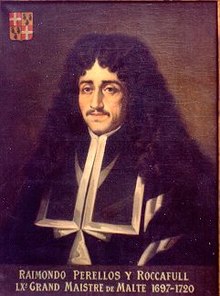Perellos
| Ramon Perellos y Roccaful | |
|---|---|
 |
|
| Grand Master of the Order of Saint John | |
|
In office 7 February 1697 – 10 January 1720 |
|
| Monarch |
King Charles III King Philip IV King Victor Amadeus |
| Preceded by | Adrien de Wignacourt |
| Succeeded by | Marc'Antonio Zondadari |
| Personal details | |
| Born | 1637 Aragon (modern Spain) |
| Died | 10 January 1720 Malta |
| Resting place | St. John's Co-Cathedral |
| Nationality | Spanish |
| Military service | |
| Allegiance |
|
Ramon Perellos y Roccaful, known in Spanish as Raimundo Rabasa de Perellós y Rocafull and in his native Catalan of Valencia as Ramon Perellós i Rocafull" (1637 in Valencia – 10 January 1720 in Valletta) was the 64th Prince and Grand Master of the Order of Malta from 1697 until his death. He was of Spanish origin and was 60 years old when he was elected as Grand Master.
Ramon Perellos (1637–1720) was the son of the Eighth Lord of Benetússer and Fifth Baron of Dos Aguas and of María de Rocafull y Vives de Boil, his consort. He joined the Order of Malta at the age of sixteen following family tradition. In 1658 he joined the board of the Master and in 1697 was elected Grand Master and remained so until his death in 1720.
Malta had organised the Consulato del Mare (Consulate of the Sea) for the first time on 1 September 1697 per initiative of Grandmaster Perellos. At the consulate it was decided that four merchants familiar enough with maritime procedures shall be appointed consuls to administer justice, on similar approach to Barcellona and Messina. Perellos had established foreign relations between Malta and Russia in 1698, for the first time, exactly a century before the Order's expulsion from Malta. During his grandmastership the coastal fortifications of Malta were strengthened by the construction of batteries, redoubts, and entrenchments. He also was the driving force behind the third rate squadron of the order which was eventually inaugurated in 1705. In 1707 he entrusted Romano Carapecchia with the reorganization of the drainage system in Valletta.
He died after 22 years as a ruler, due to illness and old age. His coat of arms was represented by three black pears against a golden background. His funerary monument is found in the Co-Cathedral of St. John in Valletta and is considered to be one of the best examples of baroque art in Malta.
...
Wikipedia
